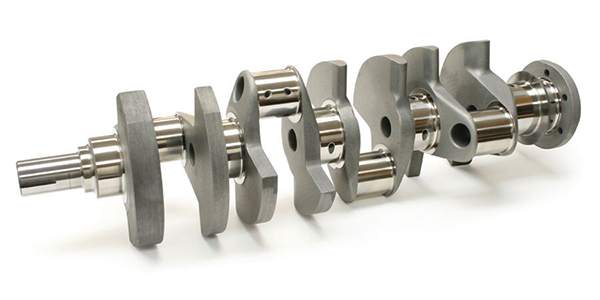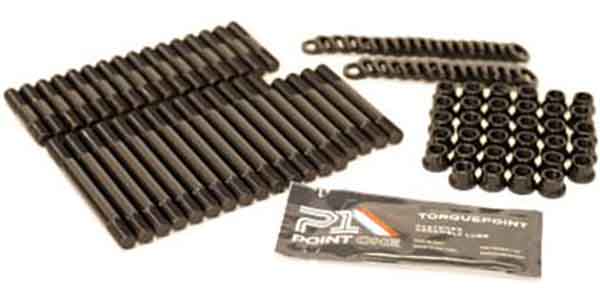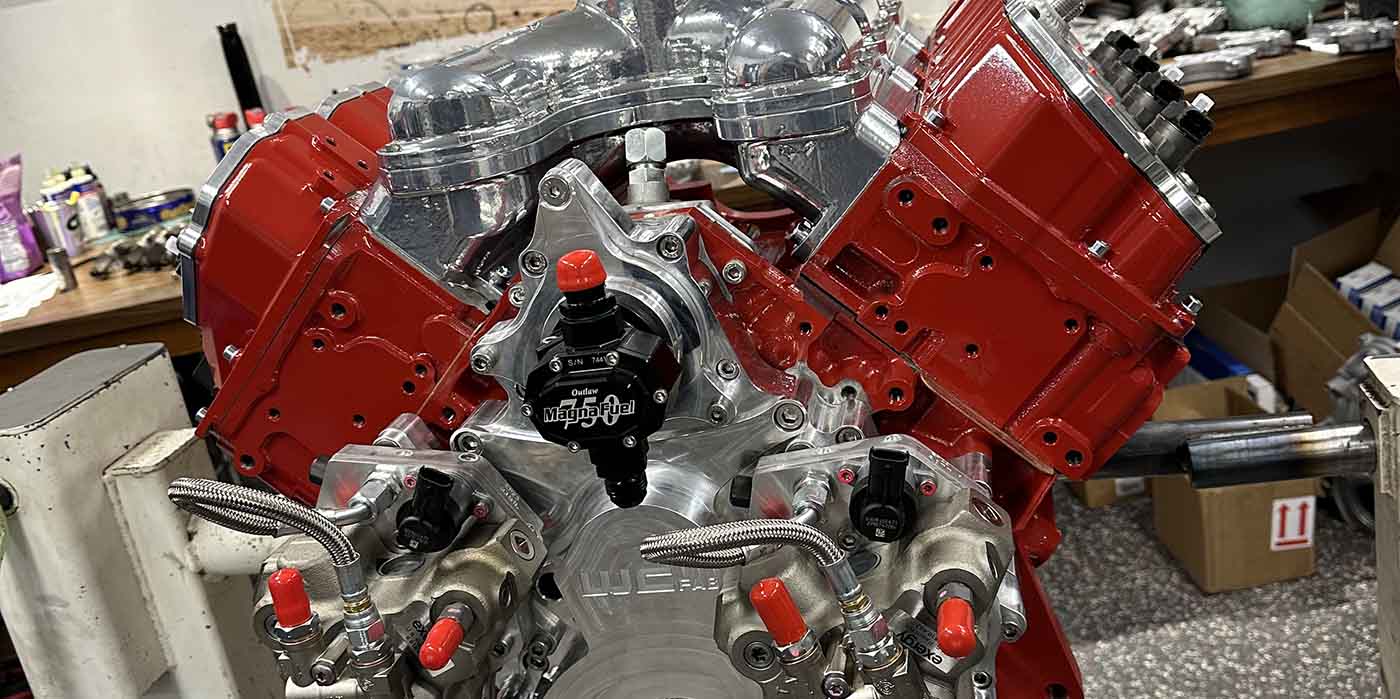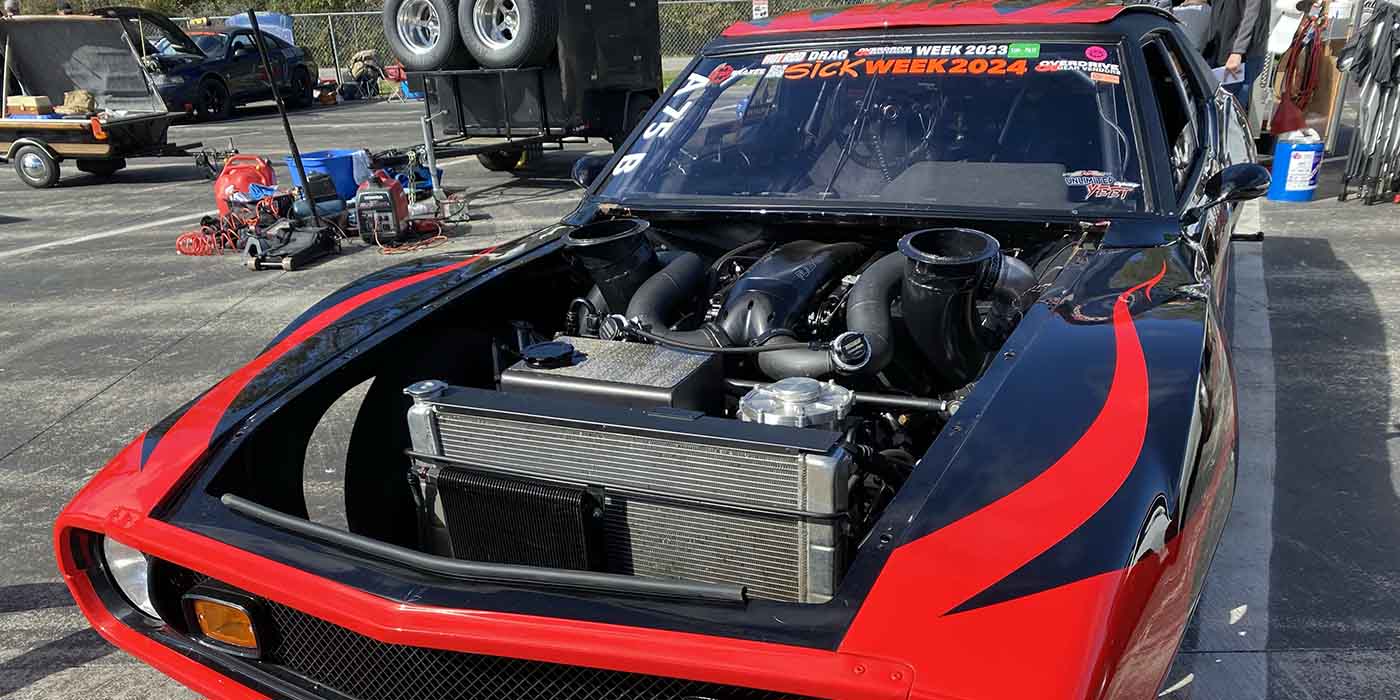Chevy strokers are pretty common. But how much do we hear about Chevy’s less produced engine, the 348/409 W motor? Surprisingly, they offer a pretty impressive number of options. Not bad for an engine that only saw production from 1958 to 1965 before being put on the shelf. Yet, the popularity of this model has continued to grow, thanks to a number of dedicated folks producing more and more modern, aftermarket parts.
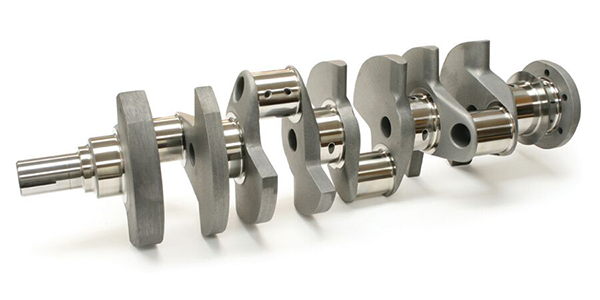
History shows us that Chevy stroked its own engine when they turned the 348s into 409s. The 348 came with a standard bore of 4.125˝ and stroke of 3.25˝. Its big brother, the 409, came with the stock bore size of 4.3125˝ and stroke of 3.50˝. That works out to an increased bore of .1875˝ and .250˝ more stroke for the 409 adding those 31 cubic inches.
What a lot of folks outside the 348/409 community don’t know, is Chevy did it again when it made it’s drag racing 409 into 427 cubic inches. The engine was the Z-11 and was usually found in lightweight, Super Stock 1963 Impalas. Only 50 or so of these were built before GM stopped it’s racing programs in early 1963. It used a neat stroker trick and we’ll explain that shortly.
Today, there are a number of manufacturers making multiple parts so the variety supports building numerous engines. Want an all-new 409? Sure, piece of cake. Wanna step it up to a 509? Yep, we can do that. In fact, even an incredible 609 is possible.
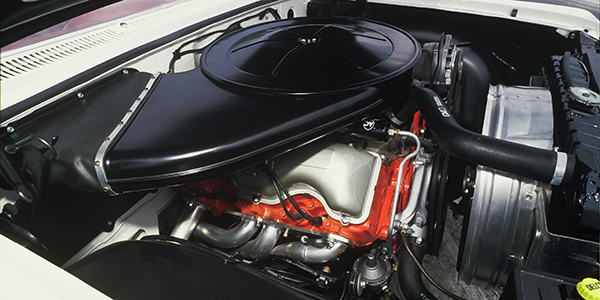
Blocks
Chevy made about 18 different 348 and 409 blocks. Some of the differences are for truck use while normal product evolution changed others. One area illustrates how Chevy built the 348 into the 409. While both oil pans share the same bolt pattern, there are two different pieces. So much so that anyone stroking a 348 might need that 409 pan and its increased clearances.
The 409 was pretty close to being tapped out for adding any more cubic inches. But Chevy wasn’t done with evolving the 409 block. For 1963, some blocks were reported to have more cylinder metal for increased boring for racing. Back in the day, one famous Z-11 was bored out .080˝ and along with added stroke, was made into a 512 cid match race motor. Imagine the reaction to a 500-plus-inch engine in 1963!
The first aftermarket block made just for 348/409 fans was actually a crossover of sorts. World Products took one of it’s proven Merlin X BBCs and created the first W replacement block in 2010. Made from 356 T6 aluminum, it can go 509 cubic inches or bigger, depending on the stroke formula used. These days, Bill Mitchell Products (BMP) still offers those aftermarket W blocks. Their BBC block was adapted to fit specific 409 patterns. First off, the decks on 348/409s are not 90 degrees like other blocks. W motors have a 74-degree deck angle and that makes the bores look slightly more oval than round. It’s also how they work with W heads in controlling compression. The second spec is the spacing of the water pump holes in front of the block. Early on, Chevy moved the ports further out from the center line of the block to get more water to the bigger bores. Remember, the W was designed to be roughly the overall physical size of a SBC. The bigger bore created more heat and architectural space was at a premium. The last change to accommodate W heads was to use their bolt footprint for those distinctive W heads.
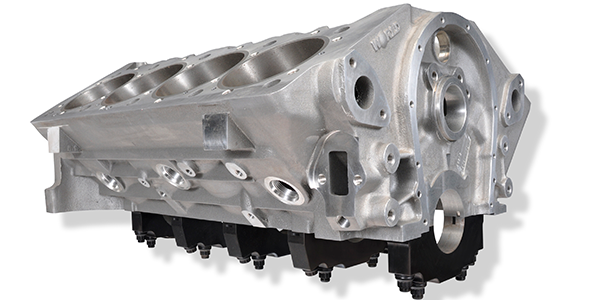
The BMP W aluminum block uses a number of BBC parts including crank, connecting rods, harmonic balancer, cam, starter, oil pump/pan, crank pulley, timing chain and cover. The block will go up to 4.250˝ stroke and requires 409 lifters, a W style water pump, upper pulleys, brackets and custom pistons. Necessary machining will include turning down the main journals. Some users of this block turn down the crank snout to accept a SBC balancer, which will fit a 348/409 crank. 409 cams are used with BBC journals. BMP added splayed, four bolt main caps. Other specs include a deck height of 9.600˝, bore sizes from 4.240˝ to 4.530˝, lifter locations match 409s and the use of a BBC distributor with .300˝ spacer.
Keeping true to the original 348/409 design, Bob Walla Racing (BWR) made its version of a 409 block and offers them in aluminum and cast iron. The aluminum blocks are poured from 356 T6 aluminum and weigh 140 lbs., while the iron block is in the 275 lbs. range. The big separation is in what each material can offer as far as sizes. The iron block, by not requiring the sleeves the aluminum blocks do, is capable of 600 cid engines. BWR aluminum blocks can run a 4.500˝ inch bore and the iron block will go up to 4.600˝ inches of bore. This yields an amazing amount of versatility as, combined with various stroke options, aluminum blocks are capable of 572 inches. BWR blocks also offer a .300˝ taller deck that can yield a total deck height to 9.900˝ to work with a 4.500˝ stroke.
BWR aluminum blocks also offer 409 or BBC architecture advantages, including the use of bigger main bearings and crankshafts, increasing that spec from 2-1/2˝ to 2-3/4˝. BMR blocks use an oiling system based on Chevy’s with priority oiling and a grooved rear journal. The mains, rod and cam bearings get the oil first with the lifters next. BWRs also offer Teflon coated cam bearings. Likewise, a BBC cam bore up to 2.120˝ is possible, as is the use of BBC oil pans. Their BBC style also opens up the use of 1045 billet steel main caps.
And speaking of oil pans, there are a number of 348/409 oil pans available. Those looking to match the factory can get a reproduction 409 oil pan at Show Cars. Racing oil pans for W motors can be found at Stef’s Performance Products for 348s and 409s.
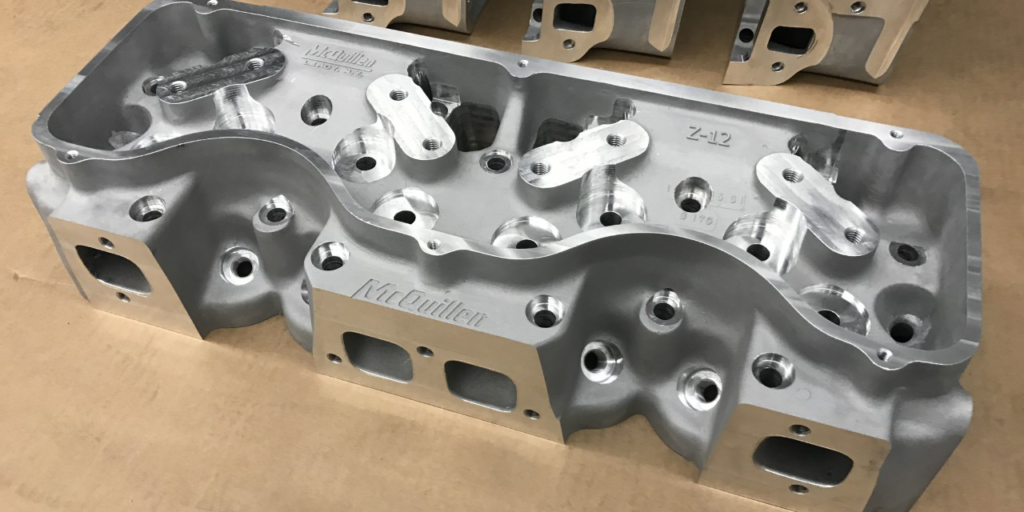
Stroker Kits
A number of suppliers make complete or partial stroker kits for 348 and 409 blocks. A complete kit usually consists of crankshaft, rods, pistons, wrist pins, rings and bearings. A partial kit may only include the crankshaft, rods and pistons. The charts that accompany this section includes many different popular stroker combinations from leading Engine Builder advertisers for Chevy engines as well as other domestic applications.
Show Cars offers its popular 409, four-inch stroker kit that is complete with Eagle crankshaft, Ross forged Pistons (with pins), GM Big Block Chevy rods, Clevite main and rod bearings and chrome moly ring set. The sizes and components vary. Another kit Show Cars offers has a 3.7500˝ stroke, and coupled with .030˝, .040˝ and .060˝ over bore sizes, the combinations are numerous. When used with Keith Black pistons, the overbores available are somewhat different at .038˝, .048˝ and .068˝ in 11:1 compression. 348s have not been left out as they offer the same 3.7500 stroke and overbore sizes.
Scat Crankshafts also makes stroker kits for both 348 and 409 blocks that include a crankshaft, rods, pistons, rings, bearings. An optional balancing package is also available. Using a four-inch stroke, the kits yield, respectively, 434 and 472 cubic inch strokers. Starting bore sizes are 4.155˝ and 4.340˝ and go from there. Connecting rods are available in both I-beam and H-beam configurations.
Eagle also makes a four-inch stroke crankshaft kit for 409s that includes Ross pistons. You have a choice of 474 or 480 inches with 4.342˝ bore for the 474 and 4.375 bore for the 480. A 6.135˝ rod is used on that four-inch stroke.
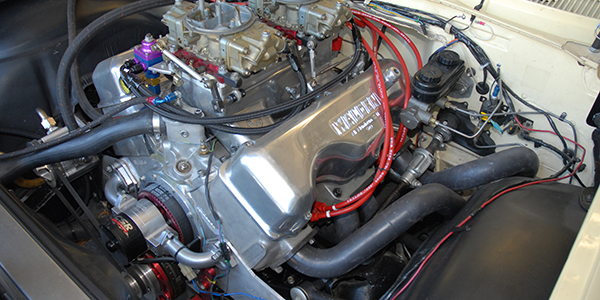
Popular stroker combinations – OEM blocks
Choices for building a 348/409 stroker start with selecting OEM or aftermarket block. So the stock blocks are a great place to start. When I wrote my 348/409 book, I got help from fellow author Steve Magnante, who turned me on to some builds.
The Edelbrock 421 Stroker is the engine they used to develop their aluminum 409 heads. They started with a 409 truck block and crank. They increased the bore by .060˝ to end up at 4.375˝ with the stock 3.500˝ stroke crank. Eagle forged H-beam rods, 6.135˝ long, were used to create 421 cubic inches with 466 horsepower and 461.9 ft.-lbs. of torque. They baselined it with stock 409 heads to get those numbers. This provided them with a good test mule for developing their new Performer RPM heads.
Superior Automotive builds a number of W motors, using both 348 and 409 blocks. Using the fact there were about four times as many 348 as 409 blocks made, these blocks are usually cheaper and more plentiful than the 409s. One of their more popular builds is taking a 348 to 434 cubic inches by boring .030˝ over to 4.125˝ and increasing the stroke with a forged Eagle crankshaft. Its four-inch stroke is 0.750˝ greater than the stock 3.250˝ stroke of a 348. The Eagle crank has a reduced counterweight diameter so it is a drop in. CVR billet steel main caps helped keep that lower end stout. Superior says that extra ¾-inch of stroke may impact some stock 348 blocks, so some machining may be necessary. Another tip is a stock 348/409 crank snout will fit a SBC harmonic balancer but the timing mark will be off. The new Eagle stroker crankshaft corrects this by relocating the keyway position. With Edelbrock Performer RPM 409 aluminum heads, an Isky solid roller cam, Ross forged 11.7:1 pistons and a CRW single plane four-barrel intake manifold, this build created 576 HP and 516 ft/lbs of torque.
Superior then took a 409 block and added a four-inch stroke to create a 481 cid W motor. This build has the potential for using many stock parts. They started with a BBC crankshaft and .060˝ overbore that ended up at 4.3725˝ inches. The crank was from a Mark IV, 454, circa 1970 – 1990 and has a two-piece rear main seal. Superior says cranks from 1991 and up won’t work with a 409 block. This swap increased the stroke by a half-inch and the results were 532 horsepower and 542 ft.-lbs. of torque. The 454 crank will need to have its mains turned down .250˝ from 2.748˝ to 2.498˝ and there is a trick here. The radius on the crank journal sides will have to be reduced from the 90 degrees of turning down. Also to be turned down is the crank snout (down to 1.250˝) to allow an externally balanced SBC Chevy 400 damper to be used. Along with that 454 crank, reconditioned stock 454 rods can be used. This build needed some block work as the 454 crank’s counterweights and connecting rods impact the bottom of the cylinder bores. Small notches will help clearance.
For this build, iron 409 heads were selected. The intake ports received basic porting and gasket matching. For valves, another relatively easy trick of installing 2.203˝/1.734˝ BBC stainless steel valves was performed. It’s an easy upgrade after the seats have been enlarged. The heads also received Manley springs and titanium retainers, Scorpion BBC 1.7 ratio aluminum roller rockers and a set of retro cast aluminum valve covers. When the heads were flow tested after their work, they confirmed the OEM “690” head is quite capable of running on 600-plus horsepower builds.
The late Lamar Walden was the guru of W motors. He revealed how to make his homemade version of the famous, 427-inch, Z-11 short block. The trick is to use a 3.650˝ stroke crank with a stock, 409 block and stock bores. The simplicity of this build is no crankshaft clearance work is needed on the block. On top of that, the bearing sizes are the same making it a ‘drop in’ yielding a 427 cubic inch short block, just like Chevy did.
It was only a matter of time before someone would use today’s technology and go big on a stock block 409. Superior recently bored one to 4.3675˝ with the use of sleeves. The stroke was 4.250˝ inches and used an Eagle crank and 6.385˝ rods. Ported Edelbrock heads, Comp cam and Weiand intake were added for a final size of 509.37 cid, 604.9 horsepower with 626 lb.-ft. of torque.
Aftermarket blocks
Using a BMP aluminum W block, Shafiroff Racing created a 509 cubic inch monster. The bore is 4.370˝, the stroke is 4.250˝ and depending on the package selected, horsepower starts at 545, stops at 565 and tops at 625 – and all those are on pump gas.
So, yeah, there are a number of options for those wishing to stroke a Chevy W engine. Sadly, though, we can’t guarantee the Beach Boys will write a song about the new size you create.

